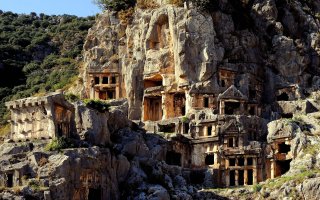5 MUSEUM YOU CAN TRAVEL İN MERSİN
1)ST.PAUL MEMORİAL MUSEUM
The St. Paul Memorial Museum building was built by the Orthodox Arab-Rum Community in 1850. Until 1993, it was used for different purposes, and in 1994 it was allocated to the Ministry of Culture and named the St. Paul Memorial Museum.
On the ceiling of the central nave of the church, which has a rectangular plan with three naves, there are frescoes of Jesus Christ, the Gospel writers Yohannes, Mattios, Marcos and Lucas, as well as the eye motif and a bird figure. On both sides of the window at the top of the apse are depictions of landscapes and angels. There is a bell tower in the north-east corner of the church.
2)MERSİN ARCHAEOLOGY MUSEUM
Mersin Archaeology Museum exhibits 1435 artifacts.
Visitors can take a journey into history in the time tunnel on the ground floor, watch how civilizations developed in every field and what they were able to do in the chronological exhibition hall, learn about the burial traditions of different cultures in the dead cult area, and visit the replica of the Hugh House near Yumuktepe Mound in the ethnographic hall, as well as ethnographic artifacts used by people from the past to the present.
3)SİLİFKE MUSEUM
By visiting the museum where archaeological and ethnographic artifacts are exhibited, you can see artifacts from the Neolithic Period, starting from 1200 BC, Archaic, Greek, Hellenistic, Roman, Byzantine, Seljuk and Ottoman periods.
4)MERSİN MARİTİME MUSEUM
Mersin Naval Museum is open to visitors with more than 500 objects revealing the history of Turkish naval warfare and a library of 800 books serving researchers. The museum provides chronological information on the history of naval warfare in the main exhibition hall of 450 square meters. In the exhibition hall, ship models, flags, coats of arms, military uniforms, cutting, piercing and firearms, and oil paintings from different periods are exhibited.
5)NARLIKUYU MOSAİC MUSEUM
Poimenios built a bath by utilizing the fresh water source that passes through the depths of the heavenly sinkhole and mixes with the sea in the small bay in Narlıkuyu, a natural wonder, and decorated its floor with a mosaic. The mosaic, created with black, white and yellow stones, depicts geometric, local bird and flower motifs and the three daughters of Zeus, the chief god of antiquity, Aglaia, Thalia and Euphrosine.
This three sisters are also called Kharites.
Derived from the word Kharis, this word means radiance, brightness and beauty.
And above this mosaic there is an inscription that reads, "O friend, if you ask who found the hidden source of the water of this beautiful bath, know that it was Poimenios, the righteous ruler of the holy islands and the friend of the emperors.













WRITE AN ANSWER